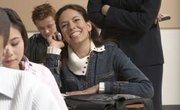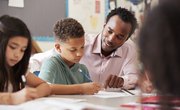Educational researcher and theorist Howard Gardner fundamentally changed curricular theory with the release of his 1983 study "Frames of Mind: The Theory of Multiple Intelligences." In this theoretical framework, students were no longer deemed blank slates on which educators could write a lifetime's worth of knowledge. Instead, Gardner argued that children enter the classroom with multiple intelligences in place and it is up to the educator to draw upon and address these intelligences to inspire learning. The naturalist learning style stands out from the others because Gardner introduced it about 15 years after the publication of his seminal work. Since its addition to the list of learning styles, it has earned its share of attention as well as controversy.
Identification
In Gardner's learning style theory, the naturalist intelligence is one that integrates and investigates the environment. Naturalist learners enjoy observing animals, interacting with pets, exploring nature, gardening, hiking and taking care of the earth. A naturalist learner requires access to outdoor areas, experiences in natural surroundings and tools that can help them explore the environment, like a magnifying glass, a telescope, a bug jar or binoculars.
Function
The naturalist learner plays a key function in a classroom setting. She may be the one to introduce science experiments such as growing seeds or collecting leaves. A class pet satisfies her need to observe and care for animals. She may prefer to read nonfiction pieces about natural wonders rather than children's picture books or fiction. Topographical maps, globes, CD-ROMs of animals in their habitats and models or dioramas about nature and creatures provide perennial fascination. A naturalist may also spearhead a school-wide recycling campaign or a celebration of Earth Day.
Features
Natural learners absorb new concepts best when they can apply information to their unique mental framework. They appreciate tools for observing phenomena and may do well if they can sketch observations in notebooks, label diagrams or record changes over time in a chart or on a graph. They often express interest in the bigger picture of a situation, wanting to debate theories or explore how everyday actions have long-term consequences.
Misconceptions
Some educators assume that a naturalist learning style is a measure of scientific proficiency. The fact is, a naturalist learner can absorb all manner of information and theory but prefers to do so within her perspective. For example, a story about China may not inspire her, but if she can link it to a map of China or photographs of unique animals and habitats in China, she will have a naturalist learner's context for considering the story.
Theories/Speculation
Gardner's amendment to his original list of learning styles was not received well by all educators. Some people feel that a naturalist learning style represents an interest as opposed to an intelligence. They feel that this descriptor limits the capabilities and scope of a broader-based intelligence. However, the naturalist learning style shares a great deal with the bodily-kinesthetic style with its preference for interaction, investigation and incorporation of tools for observation.
Related Articles
References
Writer Bio
Nina Makofsky has been a professional writer for more than 20 years. She specializes in art, pop culture, education, travel and theater. She currently serves as a Mexican correspondent for "Aishti Magazine," covering everything from folk art to urban trends. She holds a Bachelor of Arts in English from Mills College.











